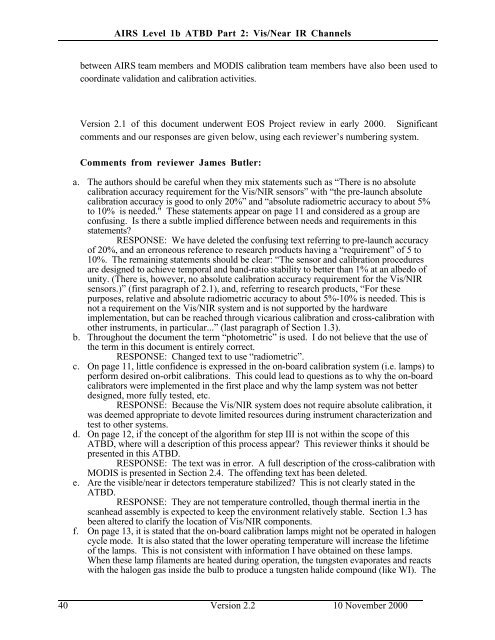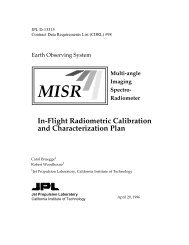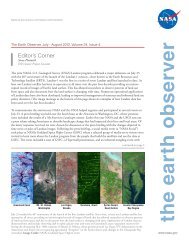AIRS Level 1B Visible/Near-Infrared Channels ATBD - NASA's Earth ...
AIRS Level 1B Visible/Near-Infrared Channels ATBD - NASA's Earth ...
AIRS Level 1B Visible/Near-Infrared Channels ATBD - NASA's Earth ...
You also want an ePaper? Increase the reach of your titles
YUMPU automatically turns print PDFs into web optimized ePapers that Google loves.
<strong>AIRS</strong> <strong>Level</strong> 1b <strong>ATBD</strong> Part 2: Vis/<strong>Near</strong> IR <strong>Channels</strong><br />
between <strong>AIRS</strong> team members and MODIS calibration team members have also been used to<br />
coordinate validation and calibration activities.<br />
Version 2.1 of this document underwent EOS Project review in early 2000. Significant<br />
comments and our responses are given below, using each reviewer’s numbering system.<br />
Comments from reviewer James Butler:<br />
a. The authors should be careful when they mix statements such as “There is no absolute<br />
calibration accuracy requirement for the Vis/NIR sensors” with “the pre-launch absolute<br />
calibration accuracy is good to only 20%” and “absolute radiometric accuracy to about 5%<br />
to 10% is needed." These statements appear on page 11 and considered as a group are<br />
confusing. Is there a subtle implied difference between needs and requirements in this<br />
statements?<br />
RESPONSE: We have deleted the confusing text referring to pre-launch accuracy<br />
of 20%, and an erroneous reference to research products having a “requirement” of 5 to<br />
10%. The remaining statements should be clear: “The sensor and calibration procedures<br />
are designed to achieve temporal and band-ratio stability to better than 1% at an albedo of<br />
unity. (There is, however, no absolute calibration accuracy requirement for the Vis/NIR<br />
sensors.)” (first paragraph of 2.1), and, referring to research products, “For these<br />
purposes, relative and absolute radiometric accuracy to about 5%-10% is needed. This is<br />
not a requirement on the Vis/NIR system and is not supported by the hardware<br />
implementation, but can be reached through vicarious calibration and cross-calibration with<br />
other instruments, in particular...” (last paragraph of Section 1.3).<br />
b. Throughout the document the term “photometric” is used. I do not believe that the use of<br />
the term in this document is entirely correct.<br />
RESPONSE: Changed text to use “radiometric”.<br />
c. On page 11, little confidence is expressed in the on-board calibration system (i.e. lamps) to<br />
perform desired on-orbit calibrations. This could lead to questions as to why the on-board<br />
calibrators were implemented in the first place and why the lamp system was not better<br />
designed, more fully tested, etc.<br />
RESPONSE: Because the Vis/NIR system does not require absolute calibration, it<br />
was deemed appropriate to devote limited resources during instrument characterization and<br />
test to other systems.<br />
d. On page 12, if the concept of the algorithm for step III is not within the scope of this<br />
<strong>ATBD</strong>, where will a description of this process appear? This reviewer thinks it should be<br />
presented in this <strong>ATBD</strong>.<br />
RESPONSE: The text was in error. A full description of the cross-calibration with<br />
MODIS is presented in Section 2.4. The offending text has been deleted.<br />
e. Are the visible/near ir detectors temperature stabilized? This is not clearly stated in the<br />
<strong>ATBD</strong>.<br />
RESPONSE: They are not temperature controlled, though thermal inertia in the<br />
scanhead assembly is expected to keep the environment relatively stable. Section 1.3 has<br />
been altered to clarify the location of Vis/NIR components.<br />
f. On page 13, it is stated that the on-board calibration lamps might not be operated in halogen<br />
cycle mode. It is also stated that the lower operating temperature will increase the lifetime<br />
of the lamps. This is not consistent with information I have obtained on these lamps.<br />
When these lamp filaments are heated during operation, the tungsten evaporates and reacts<br />
with the halogen gas inside the bulb to produce a tungsten halide compound (like WI). The<br />
40 Version 2.2 10 November 2000







